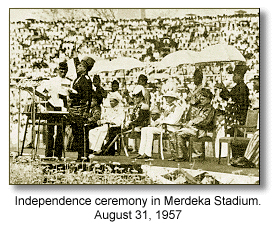
Malaysia - Independence and Onward: 1957 - Present

With 1957's independence, a new series of difficult decisions lay ahead of Malaya, the first of which was to determine exactly what territories would be
included in the new state. In 1961, the term "Malaysia" came into being after Tunku convinced Singapore, Sabah, and Sarawak to join Malaya in a federal union
(Singapore later opted out of the union, peacefully, in 1965). Afraid that the union would interfere with his expansionistic plans, Indonesia's president
Sukharno launched attacks against Malaysia in Borneo and on the peninsula, all of which were unsuccessful.
Another immediate problem was the determination of a
national identity. Malaysia was a mix of people from many
races and cultures, and uniting them under a common flag was
not an easy enterprise. Because Malays represented the
majority, the constitution gave them permanent spots in the
government, made Islam the national religion, and made Malay
the national language; but the Chinese firmly dominated
business and trade, and most Malay were suffering economic
hardships. The government, controlled by the United Malay
National Organization, passed the New Economic Policy, which
attempted to increase economic opportunity for the Malay by
establishing various quotas in their favor. Unsurprisingly,
many Chinese opposed the new arrangement and formed a
significant opposition party. In 1969, after the opposition
party won a significant seats, riots swepts through Kuala
Lumpur and the country was placed in a state of emergency
for two years. It was a painful moment in the young nation's
history that most Malaysians prefer to forget.
In the last two decades, Malaysia has undergone tremendous
growth and prosperity, and has arguably made significant
progress in race relations. Many attribute the country's
success to the dynamic leadership of Prime Minister Mahathir
bin Mohammed, who led the country from 1981 through 2003.
Malaysia's flag

Malaysia's flag is based on that of the United States, a country whose democratic ideals the young nation sought to emulate upon gaining independence from Great Britain in 1957.
The 14 stripes represent Malaysia's states, while the square in the upper left contains the moon and sun of Islam.
ISO is a non-governmental organization that forms a bridge between the public and private sectors. On the one hand, many of its member institutes are part of the governmental structure of their countries, or are mandated by their government.
more info
Iskandar Malaysia aims to be a sustainable region of international standard. The beacon of new growth, Iskandar Malaysia will spur economic developments that actuate Malaysia's global potential. Recognising the need for sustainable development, social and environmental issues features heavily on its agenda.
more info